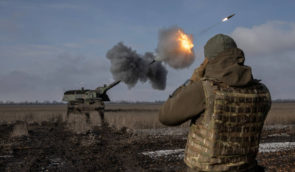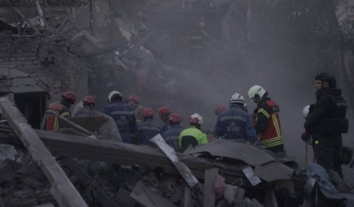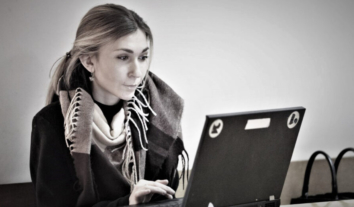Book about the Year in Occupied Crimea Presented in Kyiv
Normal
0
false
false
false
RU
X-NONE
X-NONE
/* Style Definitions */
table.MsoNormalTable
{mso-style-name:”Обычная таблица”;
mso-tstyle-rowband-size:0;
mso-tstyle-colband-size:0;
mso-style-noshow:yes;
mso-style-priority:99;
mso-style-qformat:yes;
mso-style-parent:””;
mso-padding-alt:0cm 5.4pt 0cm 5.4pt;
mso-para-margin-top:0cm;
mso-para-margin-right:0cm;
mso-para-margin-bottom:10.0pt;
mso-para-margin-left:0cm;
line-height:115%;
mso-pagination:widow-orphan;
font-size:11.0pt;
font-family:”Calibri”,”sans-serif”;
mso-ascii-font-family:Calibri;
mso-ascii-theme-font:minor-latin;
mso-fareast-font-family:”Times New Roman”;
mso-fareast-theme-font:minor-fareast;
mso-hansi-font-family:Calibri;
mso-hansi-theme-font:minor-latin;}
A presentation of the publication “The Fear Peninsula: Chronicle of Occupation and Violation of Human Rights in Crimea,” which tells about the annexation and human rights violations in the temporarily occupied territories during the past year, took place in Kyiv.
The booklet contains information gathered by Ukrainian human rights activists. It consists of analysis of violations of international law in connection with the occupation of Crimea and Sevastopol by Russian troops, the evaluation of these events by international bodies, and documentary evidence of human rights violations (kidnappings, torture, murder, political persecution) in the temporarily occupied territory of Crimea from February 2014 to March 2015.
The authors of the publication noted during the presentation that the booklet refutes the Russian propaganda about a peaceful annexation of the peninsula. The head of the Almenda Civic Education Center, Olga Skrypnyk, said that Russia de facto captured part of Ukraine’s territory through military intervention.
“Even before March 16th, major military and administrative facilities in Crimea and Sevastopol were captured by ‘green men,’ most of which were Russian military. What kind of ‘voluntary referendum’ can we talk about under occupation? Russia is trying to hush up the facts of Crimean resistance. Thus, Ukrainian and anti-war rallies were brutally dispersed, the activists were kidnapped and tortured, and independent journalists were persecuted. After that, the regime aimed for the complete collapse of fundamental rights and freedoms,” says Skrypnyk.
According to the head of the Human Rights Information Center, Tetyana Pechonchyk, we are not talking about a bloodless capture of the Crimea because at least three people were killed by the actions of Russian troops and the so-called “Crimean Self-Defense.” They are Crimean Tatar Reshat Ametov and the Ukrainian soldiers Sergiy Kokurin and Stanislav Karachevsky. Pechonchyk notes that the occupation was accompanied by the kidnapping and torture of those who either opposed the occupation or recorded violations by Russian troops and local paramilitary groups.
“First of all, we are talking about the forced disappearances of pro-Ukrainian activists (Andriy Schekun, Anatoly Kovalskiy, Olexandra Ryazantseva, Katerina Butko, Olexiy Gritsenko, Natalya Lukyanenko, Sergiy Suprun) and Crimean Tatars (Reshat Ametov), as well as journalists, photographers (Olena Maksimenko, Oles Kromplyas), and cameramen from Babylon’13 (Yaroslav Pilunsky and Yuriy Gruzinov, the latter of which is a Russian citizen),” says Pechonchyk.
According to her, there were also “accidental victims.” For example, Yuriy Shevchenko had not been interested in politics and did not engage in civic activism, but was mistaken for an activist of “some radical organization” at a railway station in Simferopol and was detained, tortured, and shot in the legs.
The Head of the Center for Civil Liberties, Olexandra Matviichuk, says that the authorities in Crimea use all possible tools for the suppression of independent civil society, and there are no mechanisms for protection from political persecution on the peninsula.
“People who carry out public work not under the control of the authorities, or have a point of view other than being pro-Russian government, are faced with the choice to either leave Crimea or terminate any public activity and remain silent”, notes Matviichuk.
“On page 33 of the book, you can find an example of a leaflet that is being posted in residential buildings. It says: ‘Although peace has been established in our land, there still are scums who want chaos, disorder, and war. They live among us, go to the same shops as we do, ride with us in public transport. You may know the people who were against the return of Crimea to the Russian Federation or have participated in the regional ‘Maidan.’ Such personalities should be reported immediately to the FSB at …’ This leaflet is a vivid illustration of the atmosphere which now prevails on the peninsula,” concludes Matviichuk.
A lawyer from the Ukrainian Helsinki Human Rights Union, Dariya Svyrydova, adds that Crimea has become a so-called “legal gray zone,” where Russian and “Crimean” legislation, which is detrimental to the protection of human rights, is applied, as well as Ukrainian law, which governs the lives of Ukrainian citizens in Crimea.
“The forced and non-transparent system of obtaining Russian citizenship, the criminal prosecution of activists, the forced deportation of dissidents, the almost complete absence of an independent judiciary in the peninsula, the daily threats and insecurity of property rights; all this became the ‘institutionalized’ reality for Crimeans under the occupation,” says Svyrydova.
The booklet is intended for representatives of human rights organizations, diplomatic missions, and government authorities. It is an important advocacy material because it contains a selection of the major decisions of international bodies on the events in Crimea, as well as basic legal acts which have been adopted by Ukraine, Russia, and the self-proclaimed Crimean government. An expert from the Regional Center for Human Rights, Sergey Zayets, notes that such a compilation would be useful for international and Ukrainian lawyers and institutions who work on the “Crimean issue.”
The publication had been previously presented on April 22nd in Strasbourg during a side-event hosted by the Ukrainian delegation to PACE, “The Annexation of Crimea: a Year After.” Tetyana Pechonchyk remarked that “The book was snatched up even before the event, not a single copy left. Representatives from the embassies are asking for more.”
The Human Rights Information Center intends to send this book to all the embassies in Ukraine. It is available for download in the English and Russian languages.







